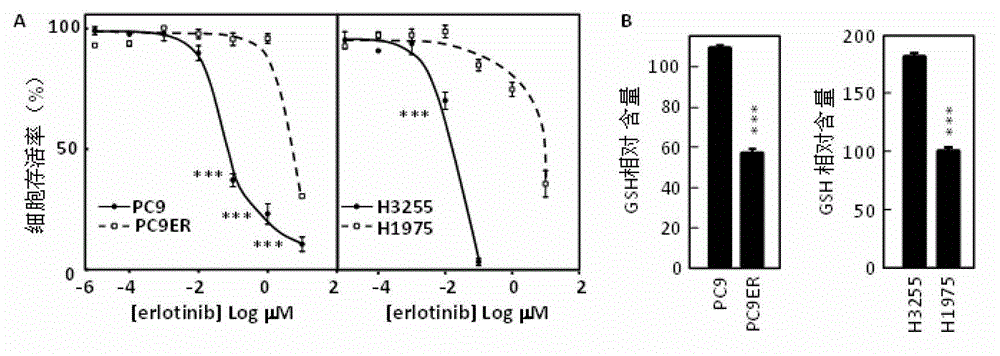Combined preparation and application of combined preparation in preparing non-small-cell lung carcinoma drug
A non-small cell lung cancer and preparation technology, which is applied in drug combinations, antineoplastic drugs, and pharmaceutical formulations, can solve drug resistance and other problems, and achieve the effect of inhibiting proliferation
- Summary
- Abstract
- Description
- Claims
- Application Information
AI Technical Summary
Problems solved by technology
Method used
Image
Examples
Embodiment 1
[0026] Example 1: Using RNA interference technology to increase the concentration of GSH in lung cancer cells (cells referred to below refer to lung cancer cells)
[0027] (1) Materials and methods of cell experiments
[0028] Using RNA interference technology (siRNA) to inhibit the expression of genes related to GSH decomposition (GGT1, GPX1, GSTpi) and GSH synthesis related genes (GSS, GCLC, GSR) to regulate the GSH content in cells. siRNA transfection was completed using RNAiMax (Invitrogen) reagent according to the instructions.
[0029] After using RNA interference technology to increase the GSH content in cells, 50nM Erlotinib was used.
[0030] (2) Results
[0031] When the RNA interference technology is used to inhibit the genes related to GSH decomposition in cells (GGT1, GPX1, GSTpi), the sensitivity of PC9 and PC9ER to Erlotinib will increase, such as figure 2 As shown in A, when GGT1 is inhibited, the relative survival number of cells is reduced by about 30%, w...
Embodiment 2
[0032] Example 2: Using drug intervention to increase the content of GSH in cancer cells
[0033] (1) Materials and methods
[0034] Lung cancer cells were treated with glutathione S-transferase inhibitor Ethacrynic acid (EA) and glutathione peroxidase (GPXs) inhibitor mercaptosuccinate (MS). The concentrations of EA and MS used were both 50 μM. After 48 hours of action, the survival rate of the cells and the GSH content in the cells were measured by the method described above.
[0035] (2) Results
[0036] Such as image 3 As shown in A, PC9ER cells resistant to EGFR tyrosine kinase inhibitors are resistant to Erlotinib (Erlo) alone, but are sensitive to the combination of Erlo and EA, and the combination of Erlo and EA reduces the survival rate of drug-resistant lung cancer cells Significantly lower than Erlo alone administration group, EA alone does not have anti-cancer effect; image 3 As shown in B, the result of combined drug use on drug-resistant H1975 cells is cons...
Embodiment 3
[0039] Example 3: Combined action of EGFR tyrosine kinase inhibitors and diuretic acid inhibits the growth of drug-resistant tumors in nude mice
[0040] (1) Materials and methods
[0041] EGFR tyrosine kinase inhibitor drug-resistant lung cancer cell PC9ER was divided into 5×10 6 The number of cells inoculated subcutaneously in the armpit of BALB / c nude mice, when the tumor volume is 100mm 3 Dosing was started, 10 rats in each group. The selected EGFR tyrosine kinase inhibitor is Erlotinib (Erlo), and the drug to increase the GSH content in lung cancer cells is diuretic acid (EA). The dosage is equivalent to the level of clinical medication, Erlo is 25mg / kg body weight / day, EA is 6.25mg / kg body weight / day, and the administration method is intraperitoneal injection. The tumor size was measured every four days with a vernier caliper, and the GSH content in the tumor was measured with a GSH kit (BioAssay Systems) after the experiment.
[0042] (2) Results
[0043] Such as ...
PUM
 Login to View More
Login to View More Abstract
Description
Claims
Application Information
 Login to View More
Login to View More - R&D Engineer
- R&D Manager
- IP Professional
- Industry Leading Data Capabilities
- Powerful AI technology
- Patent DNA Extraction
Browse by: Latest US Patents, China's latest patents, Technical Efficacy Thesaurus, Application Domain, Technology Topic, Popular Technical Reports.
© 2024 PatSnap. All rights reserved.Legal|Privacy policy|Modern Slavery Act Transparency Statement|Sitemap|About US| Contact US: help@patsnap.com










